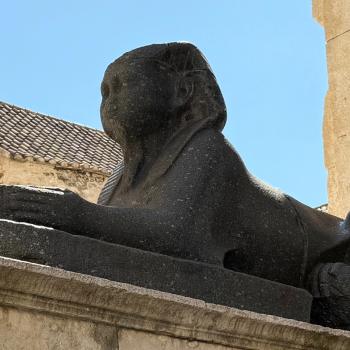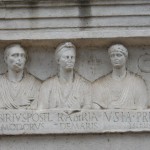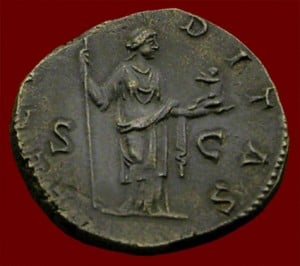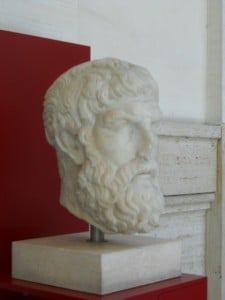When we think of a Roman house in consideration of the religio Romana we must put aside thoughts of the imperial palaces or those found at Pompeii. Instead we have to look back to the time of Numa Pompilius in the seventh century before the common era. The common house of that time was a round hut, with the door being the single opening in its walls. The roof was conical, held up by a central pole. Ritually that central pole is identified with the axis mundi, and came to be equated with the hearth in a later period. Around 650 BCE there also began to appear the great houses, such as Numa possibly lived in. These were rectangular, with three cells, and would become the model for the temples that housed the Gods beginning with the Capitolium around one-hundred and fifty years later. The temples of Rome were not used in the same way as churches, synagogues or mosques are today. They were not places of worship and most people were never allowed to enter them. Instead they were built as houses, temporary residences for the Gods to dwell in whenever They would visit the City. So it seemed natural to erect structures for the Gods that resembled the great houses of Rome’s leading citizens. The round huts that most Romans lived in at that time were used as a model for urns that held the ashes of honored dead. In a sense these hut urns were temples for the Lares – the deified ancestors of Rome. By no stretch of the imagination, therefore, the house of a Roman was also the temple of his family. As Cicero spoke before the pontiffs:
“What is there more holy, what is there more carefully fenced round with every description of religious respect, than the house of every individual citizen? here are his altars, here are his hearths, here are his household gods: here all his sacred rites, all his religious ceremonies are preserved (De Domo 109).”
Just as an edifice had to be consecrated and dedicated before it became a temple for the Gods, a Roman’s house has to be consecrated. This can only be performed by a wife, and only a woman can renew the home each year. When in ancient times a bride was first carried to her new husband’s house, she performed a ritual purification of his front door in honor of the Goddess Cardea (Fasti 6.155-166). The door was swept and washed down and then “wiped down” with either a pure cloth or with purifying herbs (verbena, juniper, or pine). The wiping-down is done in a motion of “measuring” as by taking both ends of a cloth in either hand and then moving the right hand across to stretch out the cloth, and then bringing the left hand to the right hand. Thus the entire frame of the door would be measured out as it was wiped down, thereby defining the boundaries of the doorway. The doorposts were wrapped with woolen fillets to signify their purification. Then, using a bough of arbutus or mulberry, the hinges were dabbed with olive oil, lard, or preferably wolf fat. Three leaves of the arabutus or mulberry were placed on the doorsill. The door was then aspersed three times with water (Ovid says that the water was drugged with some medicinal herb distilled in it, possibly vervain). Prayers were said while this was done, probably to Forculus, Limentius, and Cardea. Sometimes what was done in such rites was to tell the myth behind the rite as an historiola. Historiole are impromtu charms, spoken not as a formulaic prayer, but in a singsong fashion so that its rhythm goes along with your actions. The bride would call upon Cardea, asking her to protect the door and keep disease out from the home, by reminding Cardea, through telling the myth, of how she came to be the guardian of doorways along with her husband Janus. Historiole are associated with magical practices, especially that of women. Women were believed to have more magical power than men, as they are thought to be closer to the Gods, and one of the roles women had in the Roman home was to provide magical protection. The wife also hangs a wreath above the door as an offering to the Gods who protect the home. The husband, or a bachelor, could not perform this rite in the same manner or with the same effect. Men fulfilled other ritual roles, and I would imagine that for the annual purification of the door that the husband probably said his prayers to Janus, by placing his right hand on the door jam in the same fashion as Marcus Horatius did when he dedicated the Capitolium (Livy 2.8.6-8). The front door in effect is made over into a shrine of Janus and Cardea, dedicated to Janus at the same time that He is invoked to provide His numen into the door to act as Janitor (door-keeper). In another ritual, to safeguard a newborn, the father takes on the role of Janus Janitor. Significantly, too, the rex and regina sacrorum who held the highest dignity among all Roman priesthoods, would sacrifice to Janus and Juno in the Regia where they lived on the first day of every month, and on the first quarter of the moon. That is, the rex, who stood in for Numa Pompilius, and his wife, acted on behalf of the City in the same manner as the husband and wife of every Rome home. Each month, at the new moon, the first quarter, and the full moon, the home is to be ritually swept and cleaned, and sacrifices offered in order to maintain the sanctity of the home. While all household members would participate, it is the woman of the house, the domina, who directs the work and the ceremonies.
As part of these house-blessing rituals, offerings would be placed on the doorsill outside of the house for the Juno of the doorway; in other words for the feminine power of Cardea. Offerings would include a bowl of milk, perhaps with a drizzle of honey in it, a bowl of water, flowers and perhaps a lighted candle or incense. Sprinkled on the doorsill, too, would be an offering of roasted grain, crushed into a course meal and mixed with salt. In this way the numen of Cardea, that is her presence, is invited to reside at one’s doorway. Once a year, on the kalends of Februarius (1 February) a laurel wreath would be placed above the doorway, outdoors, as an additional offering. The ritual blessing of the doorway was conducted at least once a year, and most likely on the kalends or new moon of each month.
“I adorn our Juno with this garland, so that we and our house may have good fortune, happiness and prosperity (after Plautus, Trinummus 39-41).”
In the story of Cardea, as told by the poet Ovid, after Janus took her as His wife, he gave to her a branch of whitethorn as a token of His protection. In Roman wedding ceremonies, a husband likewise gives his bride a branch of whitethorn. Whitethorn, or hawthorn as it is known in the US, is a tree having long spikes on its branches. At the conclusion of the door-blessing ceremony this branch of hawthorn is hung above the door, on the inside, as a protective amulet. Its purpose is to impale any evil spirits that might bring disease or deceit into the home. Other protective amulets were placed on both sides of the doorway as well, which I shall next explain. The main point that I wish to make here, though, is that it is only through the power of a woman’s juno that such a ceremony can be performed. Every man has a genius that he receives from both the Gods Jupiter and Ceres and from his parents; a genius is that divine part of a man that lives on after death. Every woman, and every Goddess, as her own unique juno that is likewise divine. Through her own juno a woman connects with the juno of Cardea in this ceremony, as she would also enjoin the junones of other Goddesses at other times. There is a little goddess in every woman. While a man and his genius have their own gifts to contribute to the family, a home cannot be complete without the presence of the juno of a woman. And the home is so central to a family’s cultus, so sacred in the practice of the religio Romana, that one can only conclude the essential role that women hold in its tradition. There is more to this than I have explained here alone, so I hope to develop this theme more in future posts and continue to show how women played a vital role in the past and how they need to be recognized today in any attempt to revive the religio Romana.
















